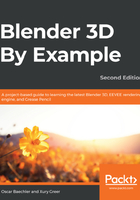
Creating a floor plan
The best place to start a project is always referencing. What look do you want? Can you pin it down to certain styles, eras, or layouts? Scour the internet for images of modern kitchens that inspire you. Blueprints are often helpful, too, and even if you don't stick to them, they can help you get an initial idea for the real-world scale of objects and layouts.
Getting our scale correct is crucial for composition. There's no point in doing a bunch of detailed modeling work in our scene only to find out that our kitchen is only big enough for ants! We'll start off by creating a simple floor plan so that we know how large everything should be:
- Start a new Blender scene.
- Go to the Top view.
- Add a mesh Plane object.
- Rename the plane to floor.
- Tab to Edit Mode.
- Press 2 to switch to Edge Select mode.
There is a viewport overlay feature that we can use to help us visualize the scale while we create the floor plan. Let's turn it on now:
- Find the viewport overlays icon at the top-right corner of the 3D View.
- Click the drop-down arrow to open the pop-over menu.
- Check the box for Edge Length under the Measurement section.
Good, now we can see the length of our selected edges in meters and we're ready to create our floor plan:
- Click on the magnet at the top of the 3D Viewport to enable snapping.
- Select an edge.
- Grab, move, and snap the edge to the grid.
- Use the Loop Cut and Extrude tools, which are required to create hallways and recesses in the floor plan.
- Switch back to Object Mode when you're done.
- Click on the magnet at the top of the 3D Viewport to disable snapping.
A floor plan does not have to be complicated; our example turned out like this:

Don't get too caught up in having the right layout. The joy of 3D is that alternative versions can be rapidly put together. If something isn't working, you can always come back and try out a new layout during this previsualization stage.
We've gone for a fancy, sleek modern kitchen for our example, so it is very large and includes space for a hallway, an outdoor area, a dining area, a sitting area, and a kitchen counter. Yours may be considerably smaller, depending on the type of kitchen you want to create. We won't know for sure whether it's a good size until we start to get some previz objects in there, so we'll take care of that next.